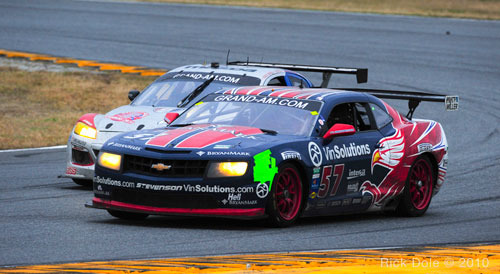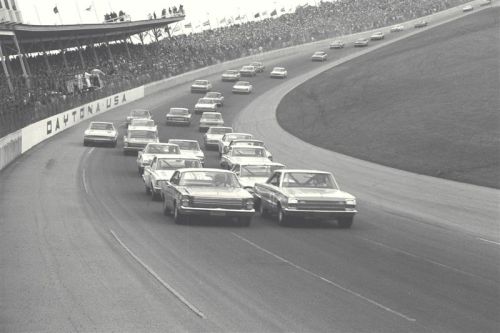FUMES
 Monday, February 1, 2010 at 12:36PM
Monday, February 1, 2010 at 12:36PM February 3, 2010
Setting the table for a new, more relevant NASCAR.
By Peter M. De Lorenzo
Editor's Note: In Part Three of an exclusive three-part series (please click on "Next Entry" at the bottom of this page to read Parts 1 &2 by going to previous "Fumes" columns dated 1/27/10 and 1/13/10), Peter outlines the most substantive and wide-ranging package of changes coming to NASCAR in years. Due to the news breaking nature of this column we'd like to give you a reminder that the entire contents of this website are ©2010 Autoextremist.com, Inc. We are more than happy to give permission to other media outlets for quotes and use of this content as long as proper attribution is given. - WG
(Posted 2/1, 12:45PM, Part III of a Series) Detroit. After a highly-confidential meeting that took place over the weekend before the Daytona 24 Hour race - and in subsequent meetings that will be played out in the early spring - it's clear that we are on the precipice of a dramatically different direction for NASCAR, one that not only marks a new era of NASCAR involvement and cooperation with the manufacturers, but a new willingness on NASCAR's part to move the needle in a positive direction, embrace change, and make genuine, substantive progress when it comes to creating more relevance between what the car companies are selling, and what NASCAR is racing.
The harsh reality.
It's no secret that this nation's near economic collapse and the following lengthy, deep recession, compounded by the added chaos of two of the Detroit Three going bankrupt - not to mention the fact that the visibly empty grandstands and declining TV rating numbers across the board at NASCAR races, and the ongoing difficulty of some teams to stay solvent - has weighed heavily on the powers that be at NASCAR headquarters in Daytona Beach. And after much hand-wringing and soul-searching, the situation has finally jarred Brian France and his team of key NASCAR leaders into facing a new and harsh reality. And that reality suggests - as outlined by newly-concerned and energized manufacturers - that they must fundamentally change what they're doing if they expect to survive as the major force in American racing.
In my previous columns I noted that two of the three domestic auto manufacturers have had new leadership teams come into place. And these leaders in question - in addition to their other duties - have a direct say as to not only what the scope of their companies' involvement in NASCAR will be, but more important, how much of their racing budgets will be directly allocated to their NASCAR racing programs. I also noted that with this transition in power has come a new emphasis on the word "relevance," as in just how willing will NASCAR be to alter its formula to accommodate the wishes of these manufacturers in terms of utilizing more advanced technologies, alternative fuels, and most important, establishing a direct visual connection between the cars sold in their showrooms and the cars that appear in NASCAR races, particularly in Sprint Cup.
Well, it appears that we will have our answers shortly.
The end of the "Car of Tomorrow" as we know it.
Over the course of the last decade, NASCAR's quest to field a starting grid of equally-spec'd cars has culminated with the disastrous adventure into the cookie-cutter shape of the "Car of Tomorrow." The "CoT" accomplished two important things for NASCAR: 1. It established a new level of safety as a direct result of the tragic accident that claimed NASCAR icon Dale Earnhardt's life. 2. It removed almost every last vestige of manufacturer involvement in establishing distinctive car shapes - and bending the rules - by making all of the car bodies nearly identical, with only decals allowed to indicate headlights, taillights, etc., for the competing manufacturers. But the third thing the CoT accomplished was not, in hindsight, something NASCAR wanted to achieve at all and that was to drive a wedge between the hard-core NASCAR faithful and their traditional brand allegiances. Being "a Ford guy (or gal)" or a "Chevy guy (or gal)" or a "Dodge guy (or gal)" may not play in many places left in the U.S., but it most definitely still plays with NASCAR's loyalist fans, and in one fell swoop NASCAR took that notion away from them with the CoT. And of course that contributed two more things to NASCAR's current predicament: empty seats in the grandstands and manufacturers who were growing unhappier by the day as they realized the net effect of NASCAR's drive for "commonality" was almost a complete loss of their brand recognition.
So what will the next-gen NASCAR "stock car" look like? Take a long look at the production-based Camaro race car (below) that ran in the GT-class in the Daytona 24 Hour, add a spoiler instead of a wing, and you will have a real good idea as to what just might be coming to NASCAR by 2012. That's right, racing cars based on real stock dimension production bodies for the first time in a long, long time. Will it be an abrupt transition? No, this is NASCAR after all, but it will be much sooner than anyone expects too. And these won't be front-wheel-drive machines masquerading in rear-wheel-drive configuration, either. The production-based nature of the new NASCAR race car will demand that the race car mirrors the production car's drivetrain configuration, which means it must be available in rear-wheel-drive on the street if it's going to be eligible to run in Sprint Cup.
 Photo Courtesy: Rick Dole Photography
Photo Courtesy: Rick Dole Photography
The shape of things to come for NASCAR.
And the way this new car may be transitioned into Sprint Cup could be very interesting, too, as NASCAR considers making the new machines - Camaro, Mustang, Challenger, a car from Toyota as yet to be determined, and any new entry from other manufacturers interested - the only cars eligible for its two road racing venues (Watkins Glen & Sears Point-Infineon). Although, with NASCAR running a Nationwide race at Elkhart Lake's Road America this summer, don't be surprised if a third road race is added to the Sprint Cup schedule by 2011 at Road America - without adding to the total number of races - with that additional road race to be run during the "Chase" for the Championship.
A new era of technology.
A new, production-based car is only just the beginning of NASCAR's fundamental transformation. Because along with these new cars will begin a new era of contemporary technology, as Brian France & Co. shores up its longstanding relationship with the manufacturers by not only adopting new technology, but by embracing the use of it enthusiastically and across the board.
What does this mean? Watch for a change in NASCAR's required fuel by 2012, with a bio fuel becoming the new standard. Also look for direct-injected engines, sequential-shift gear boxes, and a host of other new technical applications.
The most important aspect of this development is that NASCAR will be working side-by-side with the interested manufacturers to make things better and more interesting for the fans, while at the same time making things better and more relevant for the manufacturers. How is this different than before? As I said, both parties - the manufacturers and NASCAR - are embarking on a new spirit of cooperation and willingness to embrace change.
Bringing NASCAR into the Future.
It doesn't matter how the parties in question arrived at this point in my estimation, the important thing is that the realization is finally there that business as usual no longer applies, and that a fundamental transformation must take place for the benefit of all concerned.
I have been NASCAR's harshest critic by far for going on 11 years now. Do I believe that everything will be all better overnight and that there won't be any problems and missteps along the way?
In a word, no.
But I am impressed and I do believe that Brian France and his chief lieutenants have finally gotten the message and have begun to see the light, and it will benefit all fans of racing if they - and the manufacturers - get it right.
Publisher's Note: As part of our continuing series celebrating the "Glory Days" of racing, we're proud to present another noteworthy image from the Ford Racing Archives. - PMD
 (Courtesy of the Ford Racing Archives)
(Courtesy of the Ford Racing Archives)
Daytona, FL, February 27,1966. The start of the Daytona 500 at the Daytona International Speedway. Pole-sitter Richard Petty (No. 43 Petty Enterprises Plymouth) and Dick Hutcherson (No. 29 East Tennessee Motor Co. Holman-Moody Ford) lead the field into Turn One. Petty would go on to win that day with an average speed of 160.927 mph, while Hutcherson would DNF. Cale Yarborough (No. 27 Banjo Matthews Ford) finished second and David Pearson (No. 6 Cotton Owens Dodge) third in front of an announced crowd of 90,000.
See another live episode of "Autoline After Hours" hosted by Autoline Detroit's John McElroy, with Peter De Lorenzo and friends this Thursday evening, at 7:00PM EDT at www.autolinedetroit.tv.
By the way, if you'd like to subscribe to the Autoline After Hours podcasts, click on the following links:
Subscribe via iTunes:
http://itunes.apple.com/WebObjects/MZStore.woa/wa/viewPodcast?id=311421319
Subscribe via RSS:
http://www.autolinedetroit.tv/podcasts/feeds/afterhours-audio.xml





